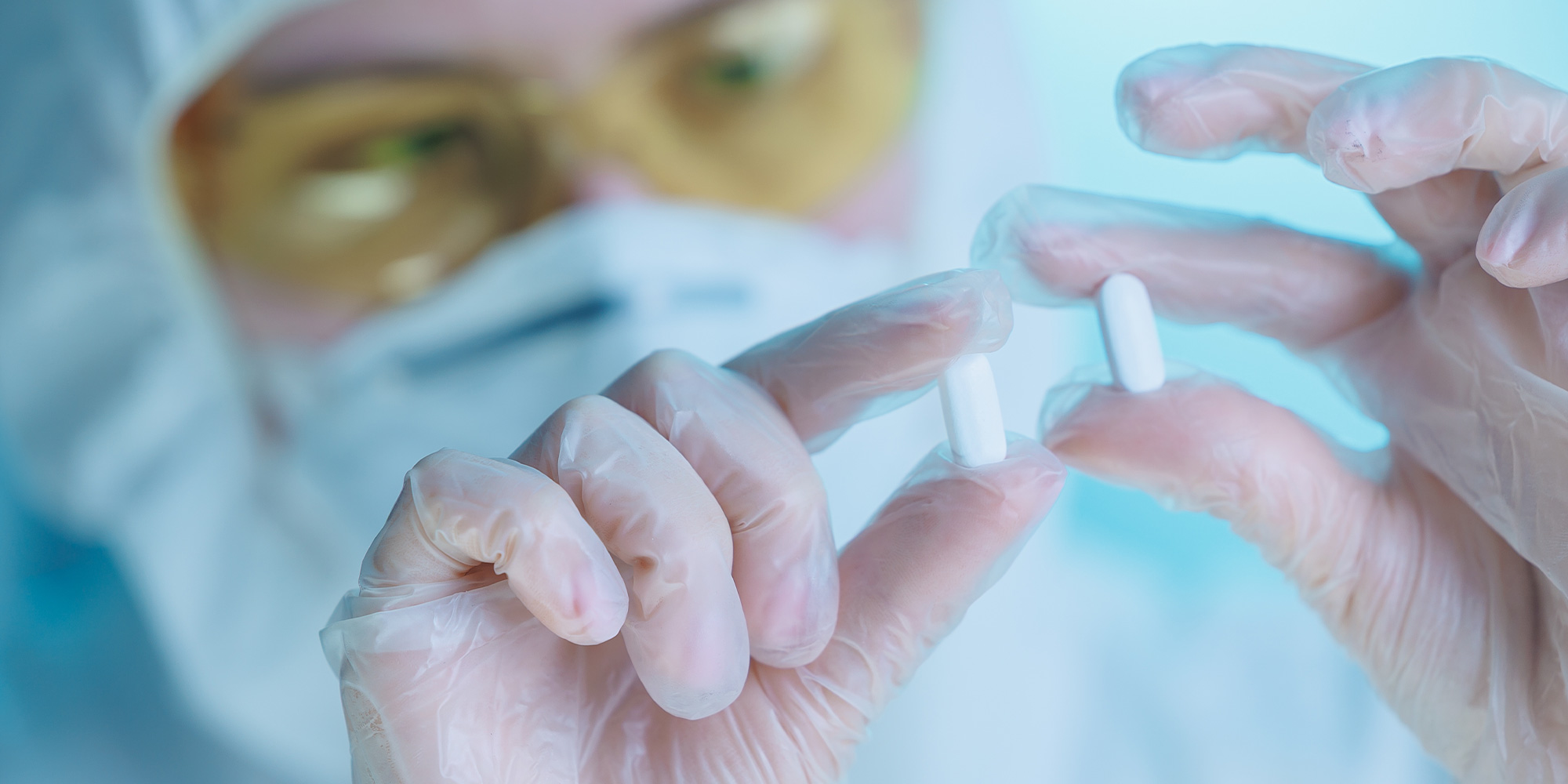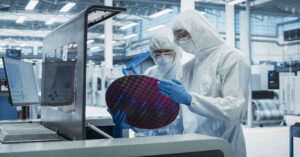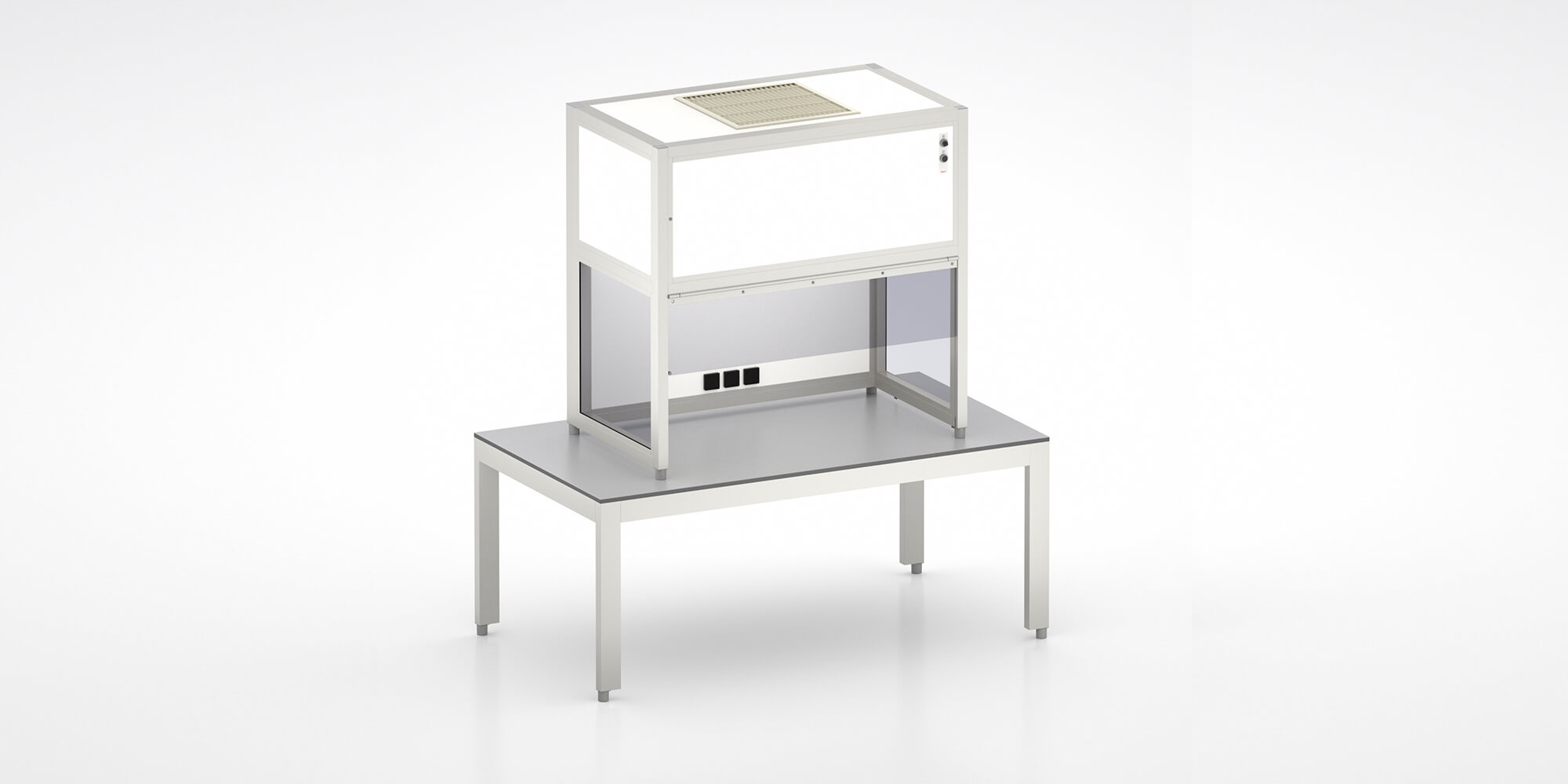To ensure safe, effective products for patients, the very highest standards of quality are an absolute must.
Cleanroom production in the medical technology
and pharmaceutical industries – a simple explanation:
- Factory equipment must be cleanroom-compatible and, in the case of medical technology, ESD-safe, too.
- When it comes to manufacturing electrical medical devices, EMC protection is vital.
- There must be no contamination, significant accumulation of particles, or outgassing.
- Hygiene, material durability and chemical resistance are also crucial factors.
- Scalable factory equipment is particularly important in the pharmaceutical industry.
- The item Building Kit System offers modular, dependable and scalable cleanroom solutions.
When manufacturing drugs – whether emergency antibiotics or precisely dosed thyroid tablets – strictly controlled conditions are absolutely vital. The same also applies to medical technology. When making medical instruments and devices – everything from surgical scalpels to pacemakers – the utmost precision and cleanliness are essential.
This level of responsibility is also reflected in the production environments. Cleanrooms lie at the very heart of manufacturing in the pharmaceutical and medical technology industries, as this is where products designed to improve people’s quality of life – or even save their lives – are made under controlled conditions.
You can use the item Building Kit System as a basis for creating safe, flexible solutions for cleanrooms. Besides cleanroom technology, you can also optimally factor in aspects such as ESD safety, EMC and automation.
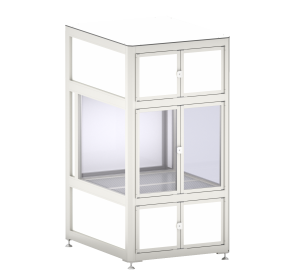
System solutions for cleanrooms
Use the modular design principle to create dependable cleanroom solutions! Whether you need a work bench with laminar flow box, a cleanroom cabin, a partial enclosure or a walk-in cleanroom, item will help you implement your solution in exactly the dimensions required.
The pharmaceutical industry – what goes on in the production environment inside the cleanroom?
This is where active pharmaceutical ingredients are prepared with excipients, granulated and made into tablets or capsules. Once they have been coated, sterilised if necessary, and put through a comprehensive quality control process, they are then packaged and released. The finished drugs are stored under controlled conditions before being delivered to pharmacies and other sales outlets.
1. Active pharmaceutical ingredient (API) production
Production begins with the manufacture of the active pharmaceutical ingredient (API). This is created by means of chemical synthesis, fermentation or biotechnological processes. The API is the primary ingredient of the drug that achieves the therapeutic effect. Completed APIs are often bought in as externally manufactured products.
2. Formulation
During this step, the API is mixed with excipients such as binders, fillers and preservatives. These excipients aid the stability, dosage and efficacy of the drug. The mixture is processed as appropriate to the desired dosage form (e.g. tablet, capsule or suspension).
3. Mixing and granulation
The API/excipient mixture is usually granulated to ensure the API is evenly distributed and to make further processing work easier. Granulation can be performed dry or wet, depending on the desired final format and the properties of the API.
4. Tableting or capsule production
The granulated mixture is pressed to form tablets or filled into capsules in cleanrooms designed for the pharmaceutical industry. During tableting, the granulate is shaped under high pressure, while capsule production involves filling the granulate into gelatine capsules.
5. Coating
Tablets are usually coated for the following reasons:
- To mask their flavour and smell
- To control the release of the API
- To improve their stability
Enteric coatings can also be used to protect the tablet from the gastric acids in the stomach.
6. Quality control
Before packaging, samples are taken from each batch and tested for quality, purity, dosage precision and stability. These tests are important to ensure that the drug satisfies regulatory requirements.
7. Sterilisation (if necessary)
In the case of sterile drugs, the API or the final product is sterilised to kill off all microorganisms. This can be carried out via autoclaving, filtration or another sterilisation method.
8. Packaging
The finished drug is packed into blister packs, bottles or another suitable packaging type. The packaging protects the product from external influences and makes distribution easier. Each packaging unit is labelled and, in many cases, a pack insert is added.
9. Final checks and release
After being packaged, the product is subjected to a final quality check before being released for delivery.
10. Storage and distribution
The packaged drugs are stored in suitable storage facilities before being delivered to pharmacies, hospitals and other sales outlets.
What are the challenges in factory equipment engineering for the pharmaceutical and medical technology industries?
There are various challenges, including compliance with strict regulatory requirements, rigorously preventing contamination and ensuring the compatibility of materials.
Documentation
Factory equipment must be designed in such a way that it:
- Meets fundamental standards and regulations such as GMP (good manufacturing practice) standards, FDA regulations and ISO standards (e.g. ISO 13485 for medical devices).
- Ensures high standards of hygiene, traceability and product safety.
This requires detailed documentation, regular inspections and the validation of all factory equipment.
Recommendations:
– By using the free item Engineeringtool, not only can you save a lot of time when designing your equipment, but detailed project information will also be generated for you automatically.
– item products are generally known for their excellent quality and dependability. Our aluminium profile fasteners have exceptionally low maintenance requirements, for example.
Cleanroom compatibility
Factory equipment must be designed:
- To satisfy the strict cleanliness requirements of the relevant cleanroom classes.
- To be easy to clean.
- To not emit any particles that could contaminate products.
Recommendations:
- Avoid open grooves. The closed grooves of item Line XMS make cleaning easier and result in joins that have minimal gap dimensions.
- Use specially developed, silicone-free products, such as those offered by item.
- Wherever possible, position horizontal surfaces such as the tops of cabinets and machine cabins at an angle to reduce the accumulation of particles.
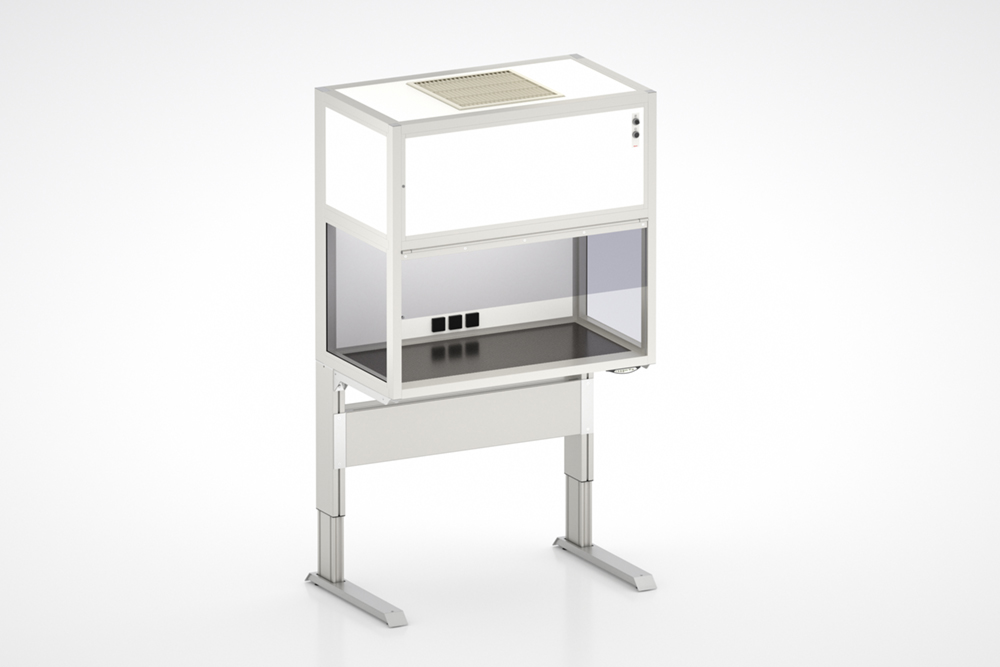
Cleaning the air with cleanroom technology
An extremely high level of air quality must be consistently maintained in cleanrooms.
Recommendations: Together with the pre-filter and HEPA filter, FFU Housing 1200×600 forms a perfect unit. HEPA Filter H14 reliably removes 99.995 percent of all particles from the air. You can use filter fan units in machine enclosures, for example.
Electromagnetic compatibility (EMC)
When it comes to electrical medical devices in particular, enclosures should be shielded against electromagnetic interference so that sensitive quality inspection processes are not compromised, for example.
Recommendations: Use panel elements that provide shielding and (wherever possible) Profile KH. This profile is not cleanroom-compatible or resistant to chemicals, but it is perfect for areas where these characteristics are not required, but EMC protection is.
Electrostatic discharge (ESD)
ESD safety in cleanrooms plays an extremely critical role in the medical technology sector. This is particularly true of vital equipment such as a heart-lung machine. Humans can sense an ESD only when it is around 3500 volts or more, but even a tiny ESD can result in a machine experiencing a highly critical failure later on.
Recommendations:
- ESD-safe work benches and matching accessories from item offer comprehensive protection. Qualified specialist staff check each and every work bench prior to delivery. When your work bench is delivered, you will also receive an ESD record documenting that your solution has been properly designed, complete with the correct discharge resistances.
- It is important to note that stainless steel is often used in cleanrooms, but this material dissipates abruptly and is therefore not ESD-safe.
- You can find online training modules all about ESD safety in the free item Academy.
Rapid adaptability of factory equipment
The pharmaceutical industry needs flexible factory equipment that can be adapted frequently in response to changing production requirements and new products. Modular customised solutions make it possible to reconfigure or extend production lines without a great deal of effort.
Factory equipment must be readily scalable so that growing demand in terms of production capacities can be met quickly, especially when manufacturing vaccines or new drugs.
Recommendations: The modularity of the item Building Kit System gives you all the flexibility you need to modify your structures whenever necessary. What’s more, you will also benefit from our guaranteed supply availability, so you can enlarge or interconnect your production systems and plants, for example – even in times of crisis.
Automation
Automated processes using collaborative robots (cobots) and conveyor belts play a key role in state-of-the-art pharmaceutical production when it comes to optimising material flows and minimising human intervention.
Recommendations:
– The item Building Kit System offers you wide-ranging possibilities for integrating cobots.
– You can use the item Conveyor Belt System to create transport solutions that are precisely tailored to your needs. For example, you can use a conveyor belt to bridge the distance between two systems.
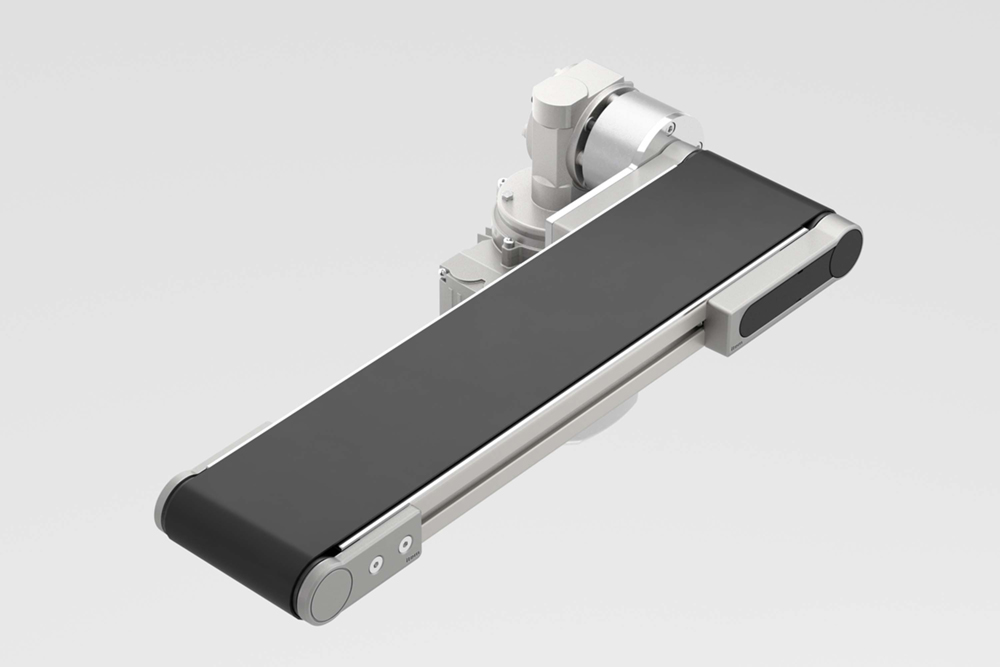
Avoiding outgassing
The materials and components used in cleanrooms must not cause any outgassing. In particular, to ensure sensitive production environments remain clean and safe, there should be no silicone or PVC present.
Recommendations: In many cases, cleanroom products from item satisfy these requirements. When bought-in parts such as automated elements are incorporated, the solution will need to be specially tested.
Particle-free transport
It is vital to ensure that transport and conveying equipment cannot generate or release any particles that could contaminate products.
Recommendations: It’s essential to choose floor elements carefully – and conductive polyurethane (PU) and polyamide (PA) are also important in terms of ESD safety.
Cleanrooms for the medical technology
and pharmaceutical industries – typical factory equipment
Cleanroom furniture, work benches and storage racks
These solutions are usually made from aluminium, stainless steel or antistatic materials to ensure that no particles are generated or released and that materials will not become contaminated in storage.
(Door) seals
These components ensure that all doors and openings in a cleanroom have an airtight seal to prevent contamination. The item Access Door system offers a wide range of options for this.
Manual material transport trolleys
Use the item building kit principle to put together special trolleys. Various item Swivel Castors are certified to ISO 14644 for use in cleanrooms.
Mini-environments
The use of shielded micro-areas (micro-environments) or laminar flow boxes inside a larger cleanroom is widespread in the pharmaceutical industry. They isolate especially critical process steps in order to maximise cleanliness (up to cleanroom class 1) on a very precise basis and prevent contamination.
This enables stricter control of air quality, temperature and pressure in sensitive areas, meaning the rest of the cleanroom does not need to comply with the very highest standards of cleanliness.
Mini-environments…
- Improve contamination control
- Enhance flexibility
- Reduce operating costs by lowering the requirements for the main cleanroom
Robot peripherals for cobots
Use the item Building Kit System to create flexible robot peripherals for cobots. It is important to note that there aren’t many cobots that meet the more stringent cleanroom requirements, but the KUKA LBR iiwa CR – which is suitable for use up to ISO class 3 – is among those that do. Specialist SCARA robots are available for the most stringent cleanroom class (ISO 1).
Cleanrooms for the medical technology and pharmaceutical industries – more solutions
- Smart signalling
- Work benches
- Racks and tables
- Linear technology
- Safety guards and enclosures
- item Stairway/Platform System
Would you like to keep up to date with developments relating to cleanrooms? Simply subscribe to the item blog by completing the box at the top right.

